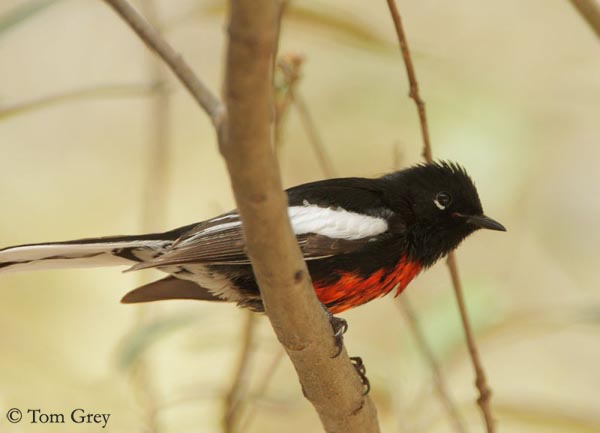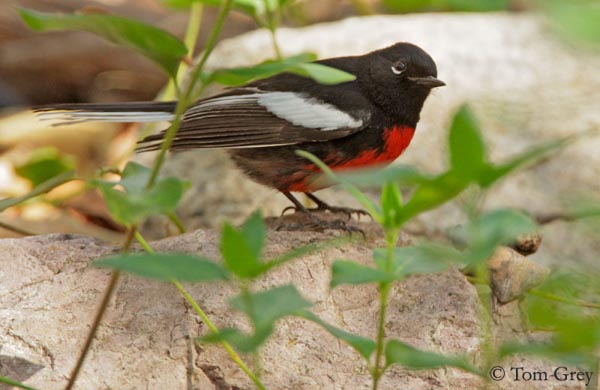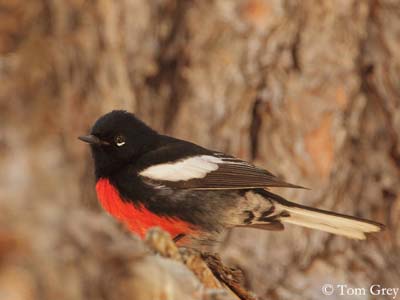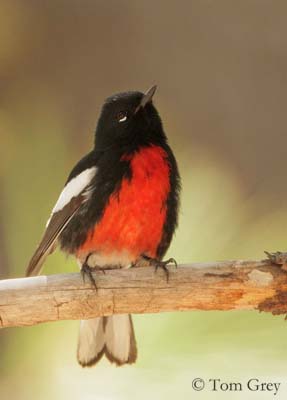
Painted Redstart
Myioborus pictus
Passeriforme Order – Parulidae Family
BIOMETRICS:
Length: 13,5-15 cm
Wingspan : 22 cm
Weight : 9,7-10 g
LONGEVITY : Up to 7 years
DESCRIPTION:
Painted Redstart can’t be confused with any other species. Its bold black, red and white colours help to identify this bird.
Painted Redstart is a large warbler. Adult has glossy black plumage all year round. A large white wing bar is formed by median and greater coverts. Tertials are white-edged. Outer tail feathers are white; median feathers are black. Black underparts show a red patch on belly. Vent is whitish.
Head is glossy black. We can see a white crescent behind the eye. Bill is thin, pointed and blackish. Eyes are black. Legs and feet are black.
Both sexes are similar.
Juvenile has entirely dark underparts, and duller plumage.
Fr: Paruline à ailes blanches
All : Rotbrust-Waldsänger
Esp : Chipe Rey
Ital : Parula pigliamosche variopinta
Nd : Roodbuikzanger
Russe : Красногрудый горихвостковый певун
Sd : Vitvingad skogssångare
Photographs by Tom Grey
His website: Tom Grey's Bird Pictures
Text by Nicole Bouglouan
Sources:
A GUIDE TO THE BIRDS OF MEXICO AND NORTHERN CENTRAL AMERICA by Steve N. G. Howell, Sophie Webb - Oxford University Press - ISBN: 0198540124
FIELD GUIDE TO THE BIRDS OF NORTH AMERICA - National Geographic Society - ISBN: 0792274512
THE HANDBOOK OF BIRD IDENTIFICATION FOR EUROPE AND THE WESTERN PALEARCTIC by Mark Beaman, Steve Madge - C.Helm - ISBN: 0713639601
All About Birds (Cornell Lab of Ornithology)
BirdLife International (BirdLife International)
SORA Searchable Ornithological Research Archive (Blair O. Wolf)
What Bird-The ultimate Bird Guide (Mitchell Waite)
Wikipedia (Wikipedia, The Free Encyclopedia)

VOICE: SOUNDS BY XENO-CANTO
Painted Redstart’s calls are a clear, whistled “chee”, and a harsh ‘sreeu”, suggesting Pine Siskin’s call. Alarm call is a high-pitched “zeeeettt”. Courtship call is a sharp, high-pitched sound, uttered during courtship flight displays.
Painted Redstart’s song is a varied rich warbler, starting quickly and ending with an up-slurred note “wee-chee, wee-chee, wee-chee…wee-cheet”.
Male uses up to ten kinds of songs, and female is able to sing just as well as a male, and during courtship displays, they sing together.
HABITAT:
Painted Redstart lives in similar habitat during breeding and wintering seasons. This species live in semi-humid oak and pine-oak woodlands, with dense undergrowth and water.
In Central America, it lives in arid to semi-humid woodlands. In winter, Painted Redstart moves to lower altitudes.
RANGE:
Painted Redstart breeds in the United States, and most birds migrate to Mexico and Central America. Small populations remain in South-eastern Arizona in winter, at lower elevation. They perform some movements and dispersions, according to the climate.
BEHAVIOUR:
Painted Redstart usually forages in shady areas, in canyon bottom or densely wooded slopes, but some birds also forage on more open areas. They forage from ground level to tree tops, on twigs, trunks and leaves.
Painted Redstart gleans from leaves, needles and branches. It also performs hover gleaning, picking insects from vegetation and spider webs. And it feeds by hawking, catching insects on the wing in several places. While foraging, Painted Redstart fans its tail and spreads its wings. It also moves body from side to side, helping to flush insects and it also exploits the anti-predatory escape behaviour of insects to catch them. Painted Redstart is an active bird, walking, hopping and climbing while foraging.

Males may perform defence displays, flicking wings and tail, jumping nervously and chasing each other. During each opening of wings, they are raised above the body in order to display the white patches to intruders, predators or other males. Male continues to sing at a close range. These interactions may lack about more or less ten minutes, and males fly away from each other.
During the nesting period, both sexes flick tail and wings, and attack other warblers too close to their nest. They sometimes fight between males.
During the breeding season, male establishes territory by singing at the boundaries. This territory is used for courting, nesting and feeding.
Painted Redstart is monogamous, but occasionally polygamous. Tail-fanning is also used in courtship displays, but slower and less frequently associated with strong hops and body-pivoting than for foraging. During pair formation and selection of nest-site, male fans its tail during the flight, but also on the ground with female.
Flight displays include flying in downwards arc with stiffened wings and fanned or half-fanned tail, and sometimes singing in flight. Female is often above the displaying male.
Young start tail-fanning when they feed themselves. They fan their tails even tail-feathers are not fully grown. Tail-fanning may be a visual cue for family members.
Courtship also includes song. Female is attracted by singing males, and pair may perform duets. These duets may also occur after pairing.
Both male and female forage together. Male chases female through vegetation, while she turns to evade it. During these energetic flights, both give courtship calls. After pair formation, they remain close together, and their singing activity is low.
Painted Redstart pair is very intolerant with other species approaching the nest. They chase them away from the nest; male may attack flycatchers and warblers.
When threatened by a predator, Painted Redstart performs quick flicks of wings and tail, calls, energetic hops, and flights over predator. Female may perform a distraction display, moving on the ground with trembling wings and calling.
Female lays 3 to 4 white or creamy eggs, speckled with brown spots. Incubation lasts about 13 to 14 days, by female alone. She makes foraging trips during the day. Male feeds her at nest during this period.
Altricial chicks have some black down on back and head. They are completely feathered at 9 days and can walk short distances. They may hop from branch to branch by flapping their wings. They are fed by both parents and brooded by female. Both parents clean the nest, removing fecal sacs and eggshells. Young leave the nest at 13 days of age.
This species produces often two broods per season. Painted Redstart nest may be parasitized by Brown-headed Cowbird, and Bronzed Cowbird.
DIET:
Painted Redstart feeds mainly on insects, and drinks sap from deciduous trees, and sugar water at feeders.
PROTECTION / THREATS / STATUS:
Painted Redstart female may abandon the nest if disturbed at the beginning of incubation. Parasitism and disturbances close to the nest may incite to abandon the nest. But any information is available about other threats.

FLIGHT:
Painted Redstart has weak fluttering flight of short duration.
REPRODUCTION:
Painted Redstart’s nest may be located on the ground, steep slopes, or rocky walls, and it is usually sheltered from above.
Female builds the nest. She may build sides and back, relatively higher than usual, creating a roof. Outer nest is made with coarse grass and pine needles, sometimes woven with leaves. Nest is lined with fine grass and hair, with some dead leaves incorporated into side walls and bottom. We can see sometimes a kind of path leading down slope from nest. Significance of this path is unknown.
